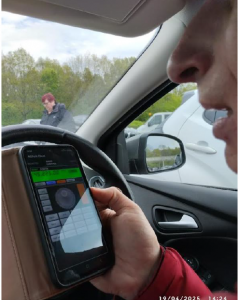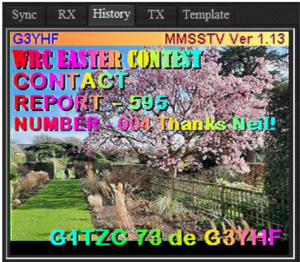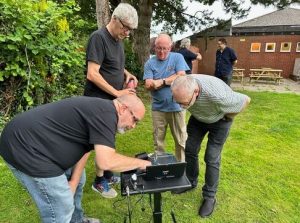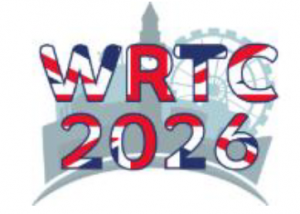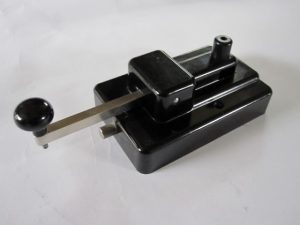
When you buy an auction lot of morse keys based on some remote auctioneer’s pictures and description, you can never be sure what you are going to find in your parcel when it eventually arrives.
Will the items be complete? Will they need extensive restoration or repair? Would it contain a rare collector’s item?
When I took the Morse Equipment Ltd Key from its packaging, I was attracted to the gracefulness of its design, its unusual spring tensioning and contact adjustment. It was in very good condition and didn’t need any restoration apart from a clean but it certainly warranted some research as to it history.
This model 605 landline key was originally known as Great Northern Telegraph Works, Copenhagen-Denmark Key and was made in the period ~1948 to 1969. However, it turns out that the key I purchased at the auction, is a British copy, made under licence by Morse Equipment Ltd, of Tring, Hertfordshire in the UK and marketed by Sedgewall Communications Group in the 1960/70’s.
I haven’t been able to exactly find out the nature of the relationship between GNTC and Morse Equipment Ltd. Both the British and Danish versions have the same pattern numbers in the Bakelite moulding.
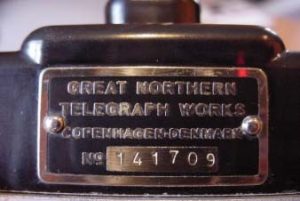
Figure 2 Label on GNT key
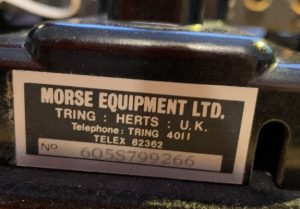
Figure 3 Label on Morse Equipment version
Looking at the base of this key I could see what looks to be spade terminals that are designed to mate with a fixed base of some kind.
From a Google search on PA3EGH’s website, I can see that GNT keys were also supplied with a Morse Inker machine 1515 which was used by the Royal Dutch Navy and other Signal Schools to check the quality of the Morse code that was transmitted by the operator.
The key clearly plugs straight into the base of the Morse Inker (See Figure 4).
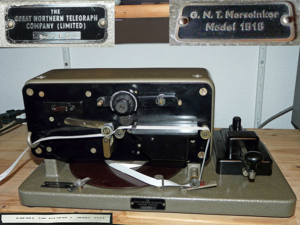
Figure 4 Morse inker machine 1515 with adjacent Key
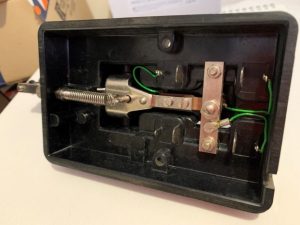
Figure 5 Under view of Key showing spade terminals
Three things stood out to when researching this key, which I thought, warranted further investigation.
- Who or what was The Great Northern Telegraph Company (GNTC) and why was this design of key attributed to them?
- Who were the Morse Equipment company of Tring UK and how did they get involved with GNTC? What other morse products did they make?
- The unusual, and possibly unique, spring tensioning arrangement on the key and its method of contact adjustment.
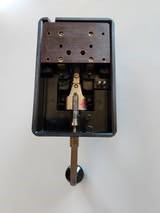
Figure 7 showing interface board fitted
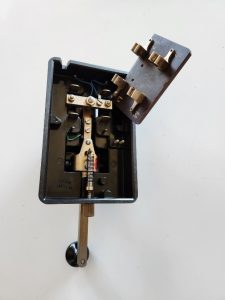
Figure 6: underside of key showing matching interface board
The Great Northern Telegraph Company (GNTC)
The origins of this company, go back to the mid-nineteenth century, where the development of the telegraphy method of sending messages in morse code, initially along railway lines, became well established and the prospect of sending telegraphic messages between countries and even continents via submarine cables became a real possibility.
The first transatlantic telegraph cable became operational on 16th August 1858, between Valentia Island of the west coast of Ireland to Trinity Bay, Newfoundland but the signal quality declined rapidly slowing transmission to an almost unusable speed. Sadly, due to an excess of applied voltage to try and improve the quality of the signal, the cable was destroyed after only 3 weeks.
A second cable was laid in 1865 with improved materials but when only half-way across it broke and was never found so repair was abandoned, A third cable was laid in 1866, luckily, they were also able to retrieve and repair the second cable so eventually there were two cables across the Atlantic.
One cannot under-estimate the impact that telegraphic communications had on the world in the nineteenth century. The ability to send and receive messages around the world in minutes rather than weeks was to have a profound effect on the commercial, political and financial life of the whole world and the race to cable up the planet was well under way by the close of the nineteenth century.
In 1868 a Dane, C.F. Tietgen, set up three small telegraph companies to connect Scandinavia, England and Russia telegraphically via submarine cables, which he did over the next three years;
- Danish-Norwegian-English Telegraph Company to lay a cable between England and Denmark and between Denmark and Norway.
- The Danish-Russian Telegraph Company to lay a cable between Denmark and Russia.
- The Norwegian- English Telegraph Company to lay a cable between England and Norway.
Shortly afterwards Tietgen merged the three companies to form the Great Northern Telegraph Company, with its headquarters and main works in Copenhagen. Throughout the rest of the nineteenth century and the beginning of the twentieth century, the company continued to expand with cables being laid across Russia via Siberia to the Russian Pacific then onto Japan and China.
The Company also started laying cables between Denmark and France and between England and Sweden and eventually between Sweden and Finland. Due to the expansion of international trade and shipping, the demand for telegraphic communications continued to grow rapidly and so the GNTC continued to expand. Figure 8 shows the 1907 route map.
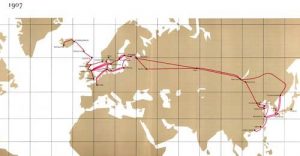
Figure 8: GNTC Route map 1907
During the First World War 1914-18, the Company was able to continue its normal activities and although some cables were damaged, repairs had to be deferred owing to the presence of mines and wartime conditions in general.
Improvements in cable technology meant that the volume of traffic was able to increase despite these war-time interruptions. The GNTC was just one of many hundreds of cable companies around the world that existed to satisfy the never-ending demand for telecommunications. Some of these were to become state-owned, some remained private corporations. Some still exist and some have disappeared completely and some are known by other names.
After the First World War, all were to feel the competition from the development of radio communication circuits as an alternative to submarine cables. The Company went on to develop radio circuits in addition to their cable routes but the competition from the predominantly state-owned radio routes gradually became tough for all cable companies.
At the same time as the rapidly increasing number of international radio circuits was limiting the volume of traffic on the Company’s submarine cables, the economics of their cables was further weakened by the decline in telegraph charge rates and by rising operating costs.
However, the Company sought to reduce the effects of these by continuous technical improvements in cable design and the development of faster transmission modes such as Telex/Teleprinter. They gave new life to the submarine cables and the use of hand sent morse started to decline.
Fortunately, during the 1930’s and 1940’s the Company developed a strategy of investing in various companies across the various industrial sectors, including batteries; radio telephones (Storno); telephones (Telematic); measuring instruments (Elmi) and hearing aids (Danavox).
In 1985, The Great Northern Telegraph Company changed its name to GN Store Nord with the aim of creating a new group identity and organising its businesses. In this process, all subsidiaries were re-named to include GN: GN Danavox, GN NetTest, GN Automatic, etc.
A major change happened in 1991 when GN was assigned the attractive GMS concession from the national Danish telecommunication authorities. In March 1992, GN’s new subsidiary Sonofon opened the first private mobile telephone network in Denmark. With the blossoming of the data communications and telephony industry, GN was back on track and enjoyed big success in the late 1990s.
In 2000, the company sold Sonofon to the Norwegian telecom operator Telenor. However, it was also about this time that the world-wide boom in telecoms companies suddenly became a bust. Many major telecommunications companies were forced to sell off subsidiaries, to avoid bankruptcy.
GN Store Nord’s headquarters are currently in Ballerup, North of Copenhagen, Denmark, focusing on its two core businesses; hearing aids and headsets, where it has demonstrated continued success in developing new technologies.
The Morse Key
I have not been able to conclusively establish who this key was designed by. I have to assume that GNTC themselves designed the key and originally manufactured it in its Copenhagen Works.
Given that GNTC established themselves as manufacturers and designers of numerous telecommunication and audio products, this would seem plausible. However, I have also seen it referenced as the Danish Ericsson Style Long Lever Key on some websites. But how did it come to be manufactured by Morse Equipment Ltd and marketed by Sedgewell Communications? What was the relationship between these three parties?
I found an advert for Morse Equipment Limited of Tring in a 1973 issue of The Wireless World, which I have reproduced below. During and after the Second World War, there was a huge demand for telegraphy equipment such as teleprinters, telex machines, inkers, undulators, perforators, tape transmitters and morse keys and the advert clearly demonstrates this. (See Figure 9)
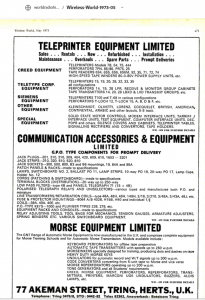
Figure 9 Morse equipment Ltd Advert from Wireless World 1973
The morse key itself is quite stylish, being housed in a fully enclosing Bakelite cover. These keys would have been used to key valve transmitters so hence the need for the safety cover to avoid touching the terminals, where there might be 50-60V at a few mA.
It has no weight to it so would have to be screwed to something substantial to avoid drifting around the operating table. This why it was designed to mate with something else via the spade terminals and fibre board arrangement. Like many morse keys from Scandinavia it has a long lever arm.
The contact points are easily adjustable from a slotted screw accessed from the top. Contact is made when the lever is pressed, and the lever arm contact rises to connect to its mating contact. The gap is easily visible through the housing so setting the gap using a feeler gauge is possible. (see Figure 10).
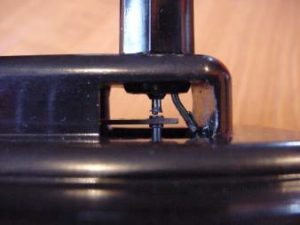
Figure 10 Contact access
Unlike most straight keys the lever arm tension spring is mounted horizontally rather than vertically and is connected to a spigot which forms part of the lever arm pivot arrangement. The spring tension is adjusted via a knurled knob which sits just under the lever arm. (see Figure 11)
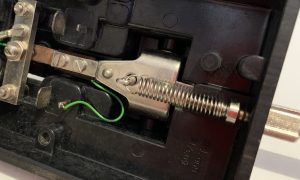
Figure 11 Spring Tensioning
I connected the key to my morse oscillator to get a feel for how it would be to use. It was ok. I could probably spend some time in getting the contact gap and spring tension more to my liking but to do that requires some time on a long QSO.
For that I need to find a suitable heavy base to give it some steadiness. I probably won’t do that, but either keep it in the collection or pass it on to another collector. I doubt it will take the place of my Marconi NATO key as my preferred straight key for operating.
Chris G0EYO
April 2025
References:
I used a great many resources to research this article. I am unable to identify individual sources but the following were very helpful;
https://atlantic-cable.com/CableCos/GreatNorthern/index.htm
https://www.tronico.fi/OH6NT/keys.htm
http://w1tp.com/imwyn.htm
http://w1tp.com/iperkcol.htm
https://www.webx.dk/oz2cpu/key6.htm
https://www.pa3egh.nl/morse-keys-from-europe/morse-keys-denmark/
https://www.facebook.com/groups/1232401453542260/ (CW Bugs, Keys & Paddles)
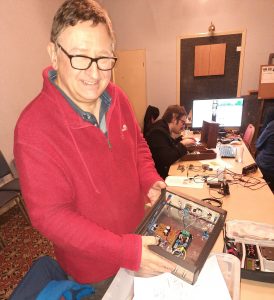 The murky gloom of a rain-drenched Midlands evening couldn’t dampen the spirits of Wythall Radio Club members…..
The murky gloom of a rain-drenched Midlands evening couldn’t dampen the spirits of Wythall Radio Club members…..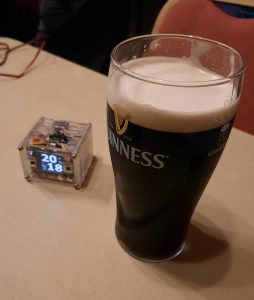 The pint of Guinness shows the compact size of Martin M0XFI’s satellite-controlled clock, contrasting with David’s home-built and cased electronic Enigma machine.
The pint of Guinness shows the compact size of Martin M0XFI’s satellite-controlled clock, contrasting with David’s home-built and cased electronic Enigma machine.









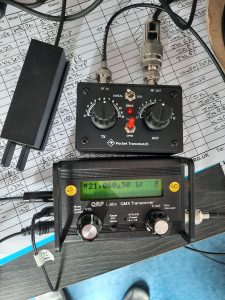 Wythall Radio Club have 2 ‘show, tell and demo’ evenings coming up….
Wythall Radio Club have 2 ‘show, tell and demo’ evenings coming up…. 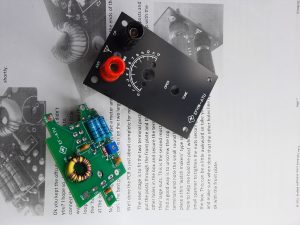 On Tuesday 11th November, we’ll focus on Neil G1TZC’s construction activities as part of his QO100 satellite station.
On Tuesday 11th November, we’ll focus on Neil G1TZC’s construction activities as part of his QO100 satellite station.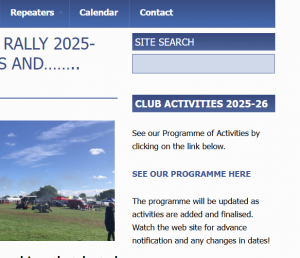
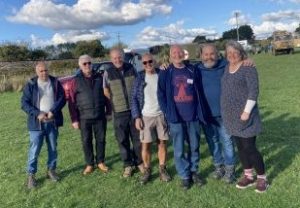 The old favourites will be there: a ‘brains trust’ Q and A (where the members are the experts!), foxhunt in Wythall Park, and Xmas and Easter contests.
The old favourites will be there: a ‘brains trust’ Q and A (where the members are the experts!), foxhunt in Wythall Park, and Xmas and Easter contests.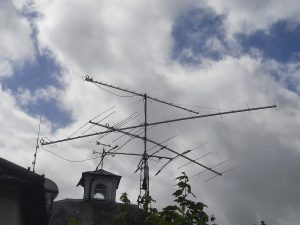
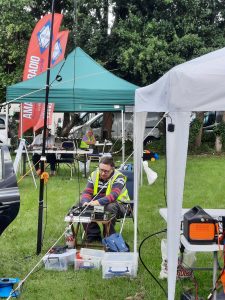 This time last year we had strong winds and lashing rain for Wythall Radio Club’s annual activation at the Transport Museum Wythall. The weather was so bad that two of the gazebos on site were damaged by strong gusts.
This time last year we had strong winds and lashing rain for Wythall Radio Club’s annual activation at the Transport Museum Wythall. The weather was so bad that two of the gazebos on site were damaged by strong gusts. 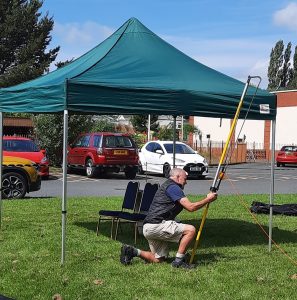 Ian decided to try locating the HF vertical on the other side of the trees and directly at the end of the wire antenna. We lashed it firmly to a wooden fence with bungy cord.
Ian decided to try locating the HF vertical on the other side of the trees and directly at the end of the wire antenna. We lashed it firmly to a wooden fence with bungy cord. 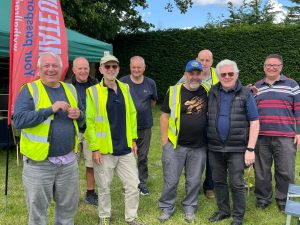 Swapping coax feeder didn’t solve the problem. Using Phil 2E0WTH’s RigExpert analyser and Ian M0LQY’s homebrew dummy load, we checked the rig and cables. Finally we traced the fault to the short piece of coax supplied with the antenna and containing several ferrites.
Swapping coax feeder didn’t solve the problem. Using Phil 2E0WTH’s RigExpert analyser and Ian M0LQY’s homebrew dummy load, we checked the rig and cables. Finally we traced the fault to the short piece of coax supplied with the antenna and containing several ferrites. 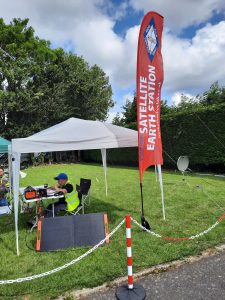 The audio from the CW/SSB station was piped through a small PA, and attracted a number of visitors – including some current and prospective radio amateurs. It competed well against the noise of passing buses and the model steam train whistle!
The audio from the CW/SSB station was piped through a small PA, and attracted a number of visitors – including some current and prospective radio amateurs. It competed well against the noise of passing buses and the model steam train whistle! 























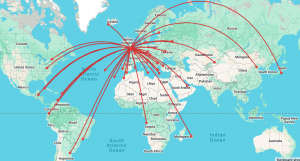 Saturday June 14th – that’s the date for Wythall RC’s annual demonstration station at Transport Museum Wythall.
Saturday June 14th – that’s the date for Wythall RC’s annual demonstration station at Transport Museum Wythall.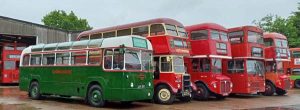
 them the 22,000 miles back to earth – so we can talk to other radio operators across much of the world.
them the 22,000 miles back to earth – so we can talk to other radio operators across much of the world.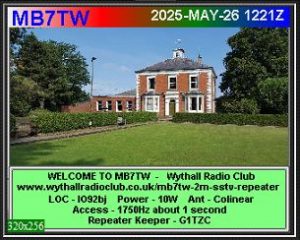 The SSTV repeater at Wythall RC – MB7TW – has been receiving frames from outside our local area during recent weeks.
The SSTV repeater at Wythall RC – MB7TW – has been receiving frames from outside our local area during recent weeks.
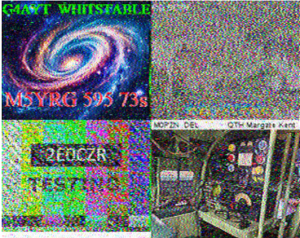
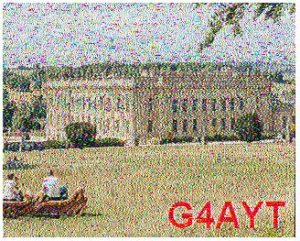

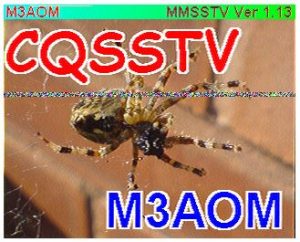
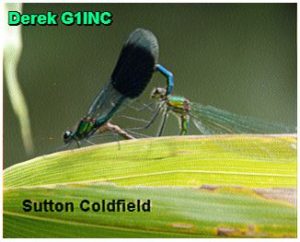
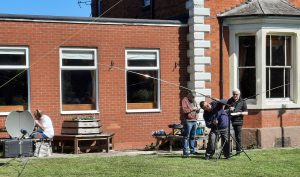
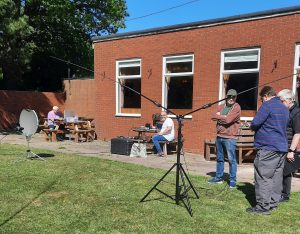 Meanwhile Ian M0LQY was using a QRPLabs QDX 5w digital transceiver and a SOTABeams bandhopper antenna to make FT8 contacts over a wide area.
Meanwhile Ian M0LQY was using a QRPLabs QDX 5w digital transceiver and a SOTABeams bandhopper antenna to make FT8 contacts over a wide area. 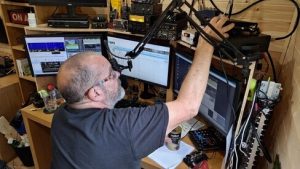
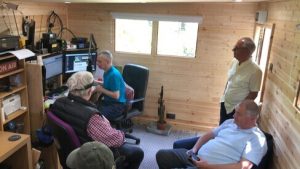

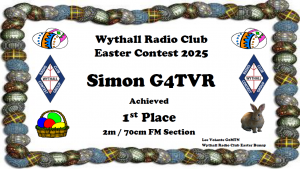 Members made use of FM, SSB, CW, FT8, D Star, Echolink and SSTV (slow scan TV – using the Club’s MB7WL SSTV repeater).
Members made use of FM, SSB, CW, FT8, D Star, Echolink and SSTV (slow scan TV – using the Club’s MB7WL SSTV repeater). 